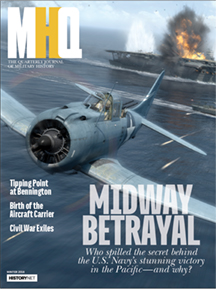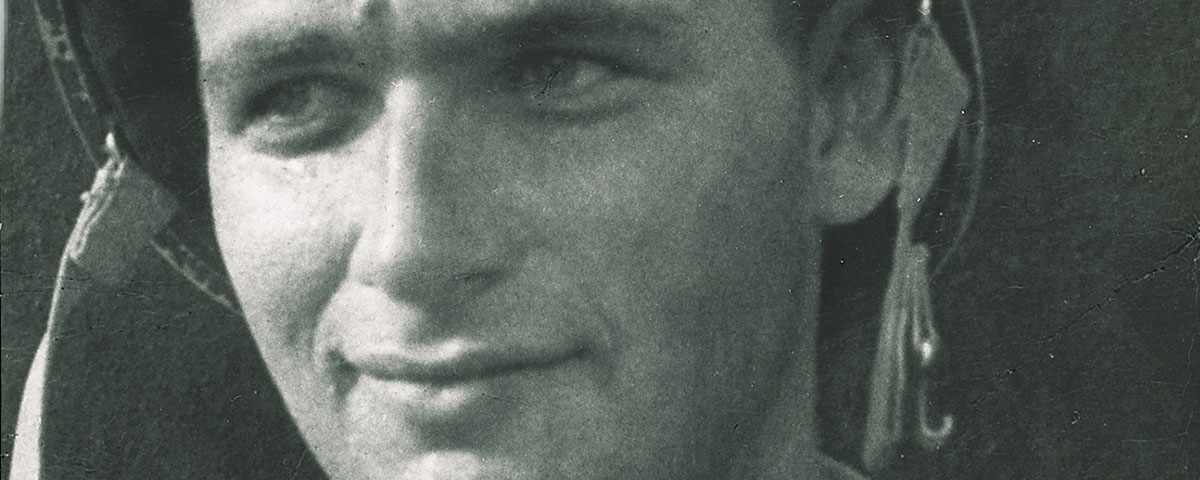Victor Lundy is best known as a modernist architect. But a set of his old sketchbooks offers a vivid visual diary of life—and death—in wartime.
“WHEN I THINK THOUGHTS,” RENOWNED MODERNIST ARCHITECT VICTOR LUNDY tells interviewers, “I draw thoughts.” Throughout his iconoclastic career as an architect, Lundy kept visual journals—“brain-boxes,” he called them—in which he captured the evolution of a project from his first ideas through completion. As a young soldier in World War II, Lundy created smaller scale versions of those brain-boxes: nearly two dozen three-by-five-inch spiral-bound notebooks, small enough to fit in a soldier’s breast pocket, filled with quick pencil drawings. The eight notebooks that survived the war are a visual diary of his seven months in the 26th Infantry Division, made up of soldiers he would later describe as “the most intelligent infantry men in the history of warfare.”
VICTORY ALFRED LUNDY WAS BORN TO RUSSIAN IMMIGRANT PARENTS on Manhattan’s Upper East Side in 1923. With his mother’s encouragement, he began seriously drawing and painting in high school. After graduation, he enrolled in the architecture program at New York University. Like most American architecture schools in the early 20th century, NYU’s used the precepts of the École des Beaux Arts in Paris: Students began each project with a quick sketch that captured the essence of a building. This training would shape Lundy’s wartime drawings.
Lundy’s education, like that of many of his contemporaries, was interrupted by America’s entrance into World War II. In the months after the Japanese attack on Pearl Harbor, he and many of his fellow architecture students took special courses in camouflage to prepare for serving as officers in a special camouflage corps. But by the time Lundy enlisted in the army in 1942, at age 19, the camouflage corps no longer existed. Instead, Lundy and other college students who passed the required examinations were placed in the newly created Army Special Training Program. They were enrolled in engineering schools across the country with the goal of producing captains in an engineering corps that would help rebuild postwar Europe.
In the winter of 1943, however, the early stages of planning for D-Day revealed a more immediate need: infantry troops to replace anticipated losses in the invasion.
Lundy had been studying engineering at the University of Maine for eight months when his commanding officer informed the ASTP enrollees there that they would be moving to Tennessee. According to Lundy, they all thought: “Oh, University of Tennessee. They have a very good engineering school.” But the CO quickly disillusioned them.Like the camouflage program before it, ASTP was being discontinued. Lundy and his fellow students were headed for the 26th Infantry Division of Lieutenant General George S. Patton’s Third Army. In a 2010 interview for the Library of Congress’s Veterans History Project, Lundy said that few of them believed that they were going into combat. In fact, he spread the rumor they were being sent to guard Chartres Cathedral—a running joke that continued until they arrived in Normandy.
On May 10, 1944, after several weeks in Tennessee, Lundy arrived in Fort Jackson, South Carolina, where he began his first sketchbook. He spent his time in lectures sketching instead of listening. The South Carolina countryside was as new to the boy from New York City as the Browning automatic rifle he received on his first day of training, and he explored both in his drawings. With an architect’s eye for the physical environment, he drew barns and haystacks as well as the camp buildings. A detailed sketch of a cot in the corner of a wooden barracks he carefully (or perhaps ironically) labeled “Home.” He caught his fellow soldiers at rest, in the 10-minute breaks they were allowed between lectures or during forced marches.
Lundy’s unit was still at Fort Jackson on D-Day, June 6, 1944. In the middle of August, after three and a half months of infantry training, Lundy and the rest of 10th Infantry Regiment of the 26th Division traveled by train to New York Harbor, where Lundy slipped out of camp to say goodbye to his family and his girlfriend. Once again, the sketchbooks document Lundy’s experience: soldiers on the train, an atmospheric drawing of the sunset on their first night at sea, and a sketch of an apprehensive young soldier labeled, “Goodbye Broadway. Hello France.”
Lundy’s unit was in the first big convoy that landed at Cherbourg Harbor in France on September 7, part of 3,000 inadequately trained and untested replacements sent to reinforce the badly depleted 26th Infantry Division.
Lundy’s first experience of the realities of war came two weeks later at Quinéville Beach, documented in a drawing he captioned “Part of the Atlantic Wall, Quinéville 6 men from L Co. hurt here, 6 killed.” Under Patton’s order, new troops spent at least two weeks training in Normandy, including visits to several of the D-Day beaches, before being assigned to units in combat. During several earlier visits to Quinéville, Lundy sketched barbed wire entanglements and camouflaged German gun positions—using his drawings to study and understand them, just as he would later sketch buildings while traveling to think through how they worked. As he was drawing the Quinéville stretch of the Atlantic Wall, he heard a popping noise in the distance. Six young soldiers had ignored a warning sign and stepped into an area the Germans had booby-trapped with “Bouncing Betty” landmines; six more soldiers jumped in to help, compounding the losses. It was an eye-opening introduction to the dangers of the war zone. (Lundy himself would have a near miss with a German booby trap baited with a package of colored pencils. He saw the prongs of the Bouncy Betty just as he was reaching for the lure.)
Lundy’s notebooks filled up. He made detailed portraits of his fellow soldiers and lyrical drawings of stone buildings in the towns they marched through—one noted as the house where he enjoyed a roast-chicken dinner served by a pretty French girl. Sometimes he made sketches as he walked with a full field pack: vigorous line drawings of soldiers in action. He used a splash of color in only one drawing—to show some blood in the snow next to a dead German.
LUNDY’S MILITARY EXPERIENCE CAME TO AN ABRUPT END ON NOVEMBER 12, 1944, when German tanks surrounded his battalion in a French village northeast of Nancy. The battalion had marched into an oddly silent village the night before. At dawn, the Germans attacked. Hundreds were killed. Lundy, now a sergeant, had two close calls. First, a large shell hit a stone house where he was resting; the house collapsed on top of him, knocking him unsconscious. Then, later that morning, a sniper’s bullet missed his ear by less than two inches. At that point Lundy’s luck ran out. He was wounded as he shepherded the rest of his squad into the cellar of a building after spotting a German tank about 25 feet away. He slammed the cellar door shut just as the tank fired. The shell went through the door and hit his left arm and shoulder.
Lundy was evacuated to an English hospital, where the doctor in charge was Hampar Kelikian, a pioneering orthopedic surgeon who may be best known for treating the war injuries of Robert Dole, the future U.S. senator, and restoring the use of his right arm. “Oh, sonny boy!” Kelikian exclaimed on finding a sketchbook in the pocket of Lundy’s tunic. “I’ve been looking for someone who could draw!” He recruited Lundy to document the creation of a radical new procedure for replacing a lost thumb. After three months in England, Lundy traveled to Walter Reed Army Hospital in Washington, D.C., where he spent most of the remainder of the war recuperating from his injuries. While at Walter Reed, he hooked up with a group of fellow patients who turned his talent with a pencil into a small business, drawing portraits of other soldiers at $50 a pop.
After the war, Lundy studied architecture at the Harvard Graduate School of Design, where one of his teachers was Walter Gropius, the founder of the Bauhaus School of design, who had fled Nazi Germany in 1934. (Lundy later reported that the hair on the back of his neck stood up when he first met Gropius, who looked exactly like the German officers he’d fought in France.)
Lundy went on to become a master of midcentury American modernism, known for his sculptural, unorthodox designs. The Library of Congress holds his archives, including his wartime sketchbooks. Lundy, now in his 90s, continues to paint and draw, using brush and pencil to help him understand the world. MHQ
PAMELA D. TOLER writes about history and the arts. She is the author of Heroines of Mercy Street: The Real Nurses of the Civil War (Little, Brown and Company, 2016) and is currently working on a global history of women warriors.
[hr]
This article appears in the Winter 2018 issue (Vol. 30, No. 2) of MHQ—The Quarterly Journal of Military History with the headline: Sketches of War
Want to have the lavishly illustrated, premium-quality print edition of MHQ delivered directly to you four times a year? Subscribe now at special savings!






